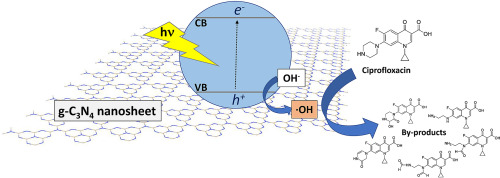当前位置:
X-MOL 学术
›
Chemosphere
›
论文详情
Our official English website, www.x-mol.net, welcomes your
feedback! (Note: you will need to create a separate account there.)
Study of intermediate by-products and mechanism of the photocatalytic degradation of ciprofloxacin in water using graphitized carbon nitride nanosheets.
Chemosphere ( IF 8.1 ) Pub Date : 2020-01-14 , DOI: 10.1016/j.chemosphere.2020.125910 Marta Jiménez-Salcedo 1 , Miguel Monge 1 , María Teresa Tena 1
Chemosphere ( IF 8.1 ) Pub Date : 2020-01-14 , DOI: 10.1016/j.chemosphere.2020.125910 Marta Jiménez-Salcedo 1 , Miguel Monge 1 , María Teresa Tena 1
Affiliation

|
The photocatalytic degradation of the antibiotic ciprofloxacin in water was carried out with nanosheets of graphitic carbon nitride (g-C3N4) as catalyst and visible light irradiation using low-power (4 × 10 W) white light LEDs. The aim of this study was to identify the intermediate by-products formed during the degradation and to propose a pathway for CIP degradation. To achieve this goal, photocatalytically degraded CIP solutions were analysed by liquid chromatography coupled to high-resolution mass spectrometry using a QTOF instrument. The accurate mass and the MS/MS data of the detected ions allowed us to determine the elementary composition of eight by-products and to propose the chemical structures for seven of them. Three of these by-products have been reported for the first time and the elementary composition of a fourth one that had been wrongly reported in the literature was accurately established. CIP degradation followed a pseudo-first order kinetics with a pseudo-first order kinetic constant of 0.035 min-1. In addition, a study of the influence of several scavengers showed that only the presence of triethanolamine dramatically reduced the pseudo-first order kinetic constant (0.00072 min-1), pointing out that the reactive species were the holes produced in the catalyst. Finally, the main pathway of CIP degradation seems to be the attack to the piperazine group by ·OH radicals, following heterocycle breakup and the subsequent loss of two of its carbon atoms as CO2 molecules, and then defluorination, oxidation and cleavage of the cycles of this intermediate.
中文翻译:

石墨化氮化碳纳米片研究中间产物和环丙沙星在水中的光催化降解机理。
以纳米碳石墨氮化碳(g-C3N4)为催化剂,并使用低功率(4×10 W)白光LED进行可见光照射,对水中的抗生素环丙沙星进行光催化降解。这项研究的目的是确定降解过程中形成的中间副产物,并提出CIP降解的途径。为实现此目标,使用QTOF仪器通过液相色谱与高分辨率质谱联用分析了光催化降解的CIP溶液。所检测离子的准确质量和MS / MS数据使我们能够确定8种副产物的元素组成,并提出7种副产物的化学结构。首次报道了其中的三种副产物,并准确确定了文献中错误报道的第四种副产物的基本组成。CIP降解遵循拟一级动力学常数,拟一级动力学常数为0.035 min-1。另外,对几种清除剂的影响的研究表明,只有三乙醇胺的存在才能显着降低拟一级动力学常数(0.00072 min-1),指出反应性物种是催化剂中产生的空穴。最后,CIP降解的主要途径似乎是·OH自由基对哌嗪基的攻击,随后是杂环分解,随后失去了两个碳原子作为CO2分子,然后脱氟,
更新日期:2020-01-14
中文翻译:

石墨化氮化碳纳米片研究中间产物和环丙沙星在水中的光催化降解机理。
以纳米碳石墨氮化碳(g-C3N4)为催化剂,并使用低功率(4×10 W)白光LED进行可见光照射,对水中的抗生素环丙沙星进行光催化降解。这项研究的目的是确定降解过程中形成的中间副产物,并提出CIP降解的途径。为实现此目标,使用QTOF仪器通过液相色谱与高分辨率质谱联用分析了光催化降解的CIP溶液。所检测离子的准确质量和MS / MS数据使我们能够确定8种副产物的元素组成,并提出7种副产物的化学结构。首次报道了其中的三种副产物,并准确确定了文献中错误报道的第四种副产物的基本组成。CIP降解遵循拟一级动力学常数,拟一级动力学常数为0.035 min-1。另外,对几种清除剂的影响的研究表明,只有三乙醇胺的存在才能显着降低拟一级动力学常数(0.00072 min-1),指出反应性物种是催化剂中产生的空穴。最后,CIP降解的主要途径似乎是·OH自由基对哌嗪基的攻击,随后是杂环分解,随后失去了两个碳原子作为CO2分子,然后脱氟,











































 京公网安备 11010802027423号
京公网安备 11010802027423号